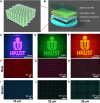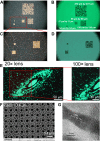Pixelation of perovskite quantum wire thin films with 0.18-μm features and 63,500-ppi pixel density
- PMID: 40367159
- PMCID: PMC12077493
- DOI: 10.1126/sciadv.adu3840
Pixelation of perovskite quantum wire thin films with 0.18-μm features and 63,500-ppi pixel density
Abstract
Halide perovskite materials excel in broad optoelectronic applications, and there is an urgent demand to develop perovskite-based integrated optoelectronic devices. However, the limitations posed by the incompatibility of perovskite thin film with wet lithography greatly hinder its potential in many important applications, including ultrahigh-density displays, high-resolution image sensors, high-density memristors, and integrated photonic circuitry. To tackle this bottleneck problem, we develop the self-aligned close-spaced sublimation growth of perovskite quantum wires and demonstrate 0.18-micrometer feature size perovskite patterns, meanwhile achieving a pixel density of 63,500 pixels per inch, the highest reported for perovskite. We showcase pixelation of perovskite quantum wires with color conversion films, addressing the need for full-color microdisplays. In addition, we demonstrate these films on curved substrates, holding promise for near-eye microdisplays. Processes shown here can also apply to other perovskite devices such as high-resolution displays, image sensing, and memristor arrays.
Figures






Similar articles
-
Mass Transfer Printing of Metal-Halide Perovskite Films and Nanostructures.Adv Mater. 2022 Sep;34(35):e2203529. doi: 10.1002/adma.202203529. Epub 2022 Jul 30. Adv Mater. 2022. PMID: 35908154
-
Wafer-scale patterning of high-resolution quantum dot films with a thickness over 10 μm for improved color conversion.Nanoscale. 2023 Nov 23;15(45):18317-18327. doi: 10.1039/d3nr04615j. Nanoscale. 2023. PMID: 37921020
-
Template Stripping of Perovskite Thin Films for Dry Interfacing and Surface Structuring.ACS Appl Mater Interfaces. 2020 Jun 10;12(23):26601-26606. doi: 10.1021/acsami.0c04006. Epub 2020 May 26. ACS Appl Mater Interfaces. 2020. PMID: 32392031
-
Thermally Evaporated Metal Halide Perovskites and Their Analogues: Film Fabrication, Applications and Beyond.Small Methods. 2025 Feb;9(2):e2301633. doi: 10.1002/smtd.202301633. Epub 2024 Apr 29. Small Methods. 2025. PMID: 38682581 Free PMC article. Review.
-
Halide perovskite single crystals: growth, characterization, and stability for optoelectronic applications.Nanoscale. 2022 Jul 7;14(26):9248-9277. doi: 10.1039/d2nr00513a. Nanoscale. 2022. PMID: 35758131 Review.
References
-
- Gu L., Poddar S., Lin Y., Long Z., Zhang D., Zhang Q., Shu L., Qiu X., Kam M., Javey A., Fan Z., A biomimetic eye with a hemispherical perovskite nanowire array retina. Nature 581, 278–282 (2020). - PubMed
-
- Zhou Y., Sun Z., Ding Y., Yuan Z., Qiu X., Cao Y. B., Wan Z., Long Z., Poddar S., Kumar S., Ye W., Chan C. L. J., Zhang D., Ren B., Zhang Q., Kwok H.-S., Li M. G., Fan Z., An ultrawide field-of-view pinhole compound eye using hemispherical nanowire array for robot vision. Sci. Robot. 9, eadi8666 (2024). - PubMed
-
- Gallop N. P., Maslennikov D. R., Mondal N., Goetz K. P., Dai Z., Schankler A. M., Sung W., Nihonyanagi S., Tahara T., Bodnarchuk M. I., Kovalenko M. V., Vaynzof Y., Rappe A. M., Bakulin A. A., Ultrafast vibrational control of organohalide perovskite optoelectronic devices using vibrationally promoted electronic resonance. Nat. Mater. 23, 88–94 (2024). - PMC - PubMed
LinkOut - more resources
Full Text Sources

